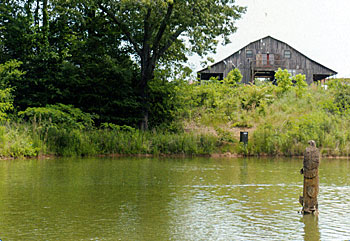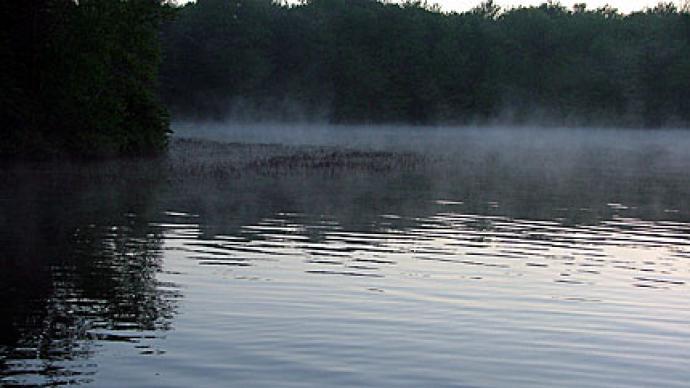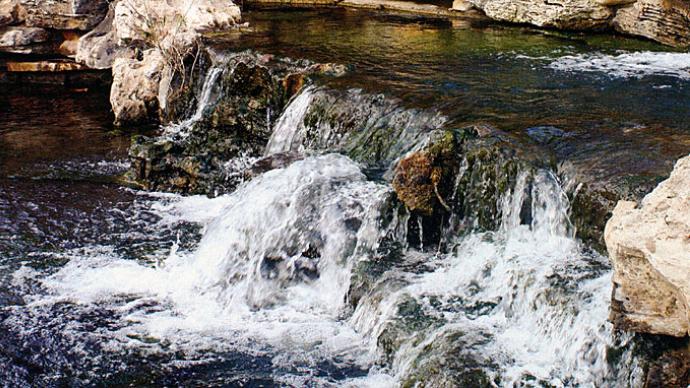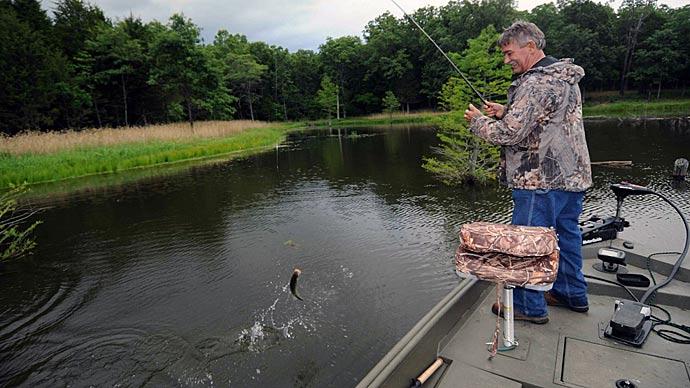
The temperature of water affects its behavior. Because of that, the temperature of water affects the biology of your pond. Then, the biology of your pond affects the chemistry of that same water. It's a fascinating relationship and can be hard to understand.
Here's what I mean. Pure water freezes at 32° F. Ice floats. That means ice is less dense than water at warmer temperatures, except when it boils at 212° F. Then, water is vapor.
But, in your pond, water temperatures tend to range from freezing upward into the 90's, depending on the season and where you live. Water is most dense at 39° F. That means water weighs more at that temperature than any other.
We're headed into spring and water temperatures will begin to rise because days are longer, the sun is more directly overhead and there's more heat to offer. Water absorbs heat, but as the water warms, heat energy derived from the sun wants to rise. The sun can only penetrate down into the water so far and the wind helps as much as it can. But, the wind moves water horizontally, creating an elliptical-shaped current. Between wind and wave action and penetration of sunlight, heat will only go down so far.
Water warmer than 39° expands, so it doesn't weigh as much as the cooler water. That means you'll soon have a warm layer of water sitting atop a cooler layer of water. The dividing line between those two layers is called the thermocline.
As spring yields to summer, the temperature differences between layers becomes significantly more profound.
But wait, there's more.
That top layer absorbs oxygen via contact with the atmosphere and from photosynthesis from plants.
Here's where it gets even more interesting. As the water temperatures rise, the wet stuffs affinity for oxygen drops. Cold water may hold 10 parts per million (ppm) of oxygen, but as the temperature rises, water in the upper 80's may only hold 6 or 7 ppm, depending on elevation from sea level.
One of the fascinating facts about water is how the biology begins to change as the temperature changes. A classic example of that is plant life. Different plants, from microscopic, single cell algae, to macrophytes with deep roots thrive because several things happen...starting with water temperature.
As plants grow, they take up nutrients, metals and minerals currently dissolved in the water. Plants respire when the sun isn't out and they photosynthesize when they can get energy from' the sun. That means plants have a cycle running between carbon dioxide and oxygen, all day and all night. They convert oxygen from carbon dioxide during sunlight and vice versa when the sun is gone.
The biology of water at that temperature is dynamic. As plants do what they do, the pH of water can fluctuate during the course of the day. This is where things get tricky and hard to understand. During a normal day, there's a balancing act between carbon dioxide, carbonates, bicarbonates, carbonic acid and minerals that contain carbonates, like lime or gypsum. That balancing act, affected by respiration and photosynthesis influences the pH of your pond. And, all that starts with the temperature.
That scientific principle is one of the key reasons biologists tell you to keep your alkalinity at least 20 ppm or higher. Not only does alkalinity help fuel a healthy pH range, it buffers excess acid like that old family favorite, Alka-Seltzer.
To keep this from becoming so confusing I can't explain it, understand when water temperatures rise, it invites biology. Biology changes water chemistry, sometimes for the better and sometimes for the worse. Part of our job is to know that and to check our water chemistry from time to time to see if we need to amend it.
When your biologist talks to you about primary productivity, he or she is describing what happens when the water temperature rises into a window where those microscopic alga can thrive. If your water has enough of the right types of nutrients, plankton grow and your water changes color to a nice green shade. Plankton feed on dissolved nutrients and then zooplankton (microscopic animals) feed on the plant plankton (phytoplankton). As zooplankton grow, small insects feed on them. That's primary productivity.
As this process increases, small insects feed larger ones which, in turn, feeds small, newly hatched fish. As those fish grow, they'll feed higher up in the food chain.. .or at least some of them will. Some fish eat plants, some fish eat meat.
So, as all these amazing biological things happen, you can imagine the games your water is playing to keep itself balanced.
Remember this—one of Nature's rules is to seek balance. Coyotes eat small game, until the small game is gone, then the coyote numbers adjust themselves via survival of the fittest. When coyote numbers drop, small game populations rise. It's an ebb and flow cycle, always seeking balance, but rarely achieving it for more than a moment in time.
Your pond is doing the same thing, with a strong focus on the balance of water.
As the temperature of water rises, it invites different species to thrive. A classic example of that is what happens with plankton blooms. Plankton thrives during spring and early summer. But, as these cycles go, phytoplankton feeds zooplankton. When the zooplankton population expands exponentially, that ecosystem can run out of food and collapse. Dead zooplankton drop to the bottom, maybe decompose and dissolve back into the water, maybe not. In their wake, the water is often left with a temporary imbalance of nutrients, often heavier with phosphorus than nitrogen. When that happens, warm water often grows blue-green algae, a bacteria that can wreak havoc on the entire ecosystem and surrounding ecosystems.
Ponds during the hottest months actually tend to slow the biology of fish and some species of rooted plants. Since fish are cold-blooded animals, they have peak operating temperatures and hot water isn't peak. Fish seek cooler water with enough oxygen to be able to breathe without dying.
Oh, and remember that thermocline thing? It stays there all summer, unless you aerate. Water beneath the thermocline is heavy and since it doesn't communicate with the water above it, loses its oxygen to decaying plant life and animals that long since breathed it to death. When the temperature of the top layer drops to the temperature below the thermocline, the two layers mix. That's called a turnover. If that lower layer is too toxic, it will taint the upper layer as the two mix and fish can die. So can plants.
So, here's your bottom line. Temperature matters. It affects the biology, which affects the chemistry. While none of us will ever have the wherewithal to do anything about the sun and its magical heating power, there are some things we can do to minimize the risks associated with the rise and fall of our water's temperature.
Aeration can help stabilize the temperature and prevent stratification and the thermocline by vertically mixing the water top to bottom. We can amend our water with minerals to help stabilize the chemistry and the water's ability to handle its primary productivity in a healthy way. We do that with lime, gypsum, and some-times aluminum sulfate. But, we can also adjust primary productivity by monitoring and adding nutrients to maintain a healthy balance. We do that with phosphorus and nitrogen, most of the time.
So, let me ask you, "Does water temperature affect the way your pond acts?"
Reprinted with permission from Pond Boss Magazine



